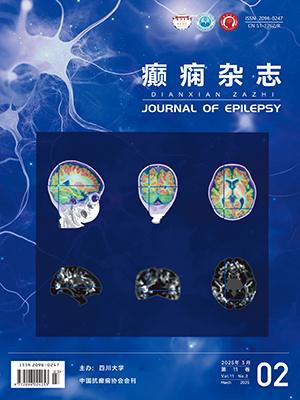| 1. |
Ngugi AK, Bottomley C, Kleinschmidt I, et al. Estimation of the burden of active and life-time epilepsy:a meta-analytic approach. Epilepsia, 2010, 51(5):883-890.
|
| 2. |
Kwan P, Brodie MJ. Early identification of refractory epilepsy. The New England Journal of Medicine, 2000, 342(5):314-319.
|
| 3. |
ZhaKwng C, An P, Zuo Z, et al. The transport of antiepileptic drugs by P-glycoprotein. Advanced Drug Delivery Reviews, 2012, 64(10):930-942.
|
| 4. |
Lazarowski A, Czornyj L. Potential role of multidrug resistant proteins in refractory epilepsy and antiepileptic drugs interactions. Drug Metabolism and Drug Interactions, 2011, 26(1):21-26.
|
| 5. |
Curatolo P, Jówiak S, Nabbout R, et al. Management of epilepsy associated with tuberous sclerosis complex (TSC):clinical recommendation. European Journal of Paediatric Neurology, 2012, 16(6):582-586.
|
| 6. |
Sosunov AA, Wu X, McGovern RA, et al. The mTOR pathway is activated in glial cells in mesial temporal sclerosis. Epilepsia, 2012, 53(Suppl 1):78-86.
|
| 7. |
Meng XF, Yu JT, Song JH, et al. Role of the mTOR signaling pathway in epilepsy. Journal of the Neurological Sciences, 2013, 332(1/2):4-15.
|
| 8. |
Berdichevsky Y, Dryer AM, Saponjian Y, et al. PI3K-Akt signaling activates mTOR-mediated epileptogenesis in organotypic hippocampal culture model of post-Traumatic epilepsy. The Journal of Neuroscience, 2013, 33(21):9056-9067.
|
| 9. |
Wang Y, Zhou D, Wang B, et al. A kindling model of pharmacoresistant temporal lobe epilepsy in Sprague-Dawley rats induced by Coriaria lactone and its possible mechanism. Epilepsia, 2003, 44(4):475-488.
|
| 10. |
Racine RJ. Modification of seizure activity by electrical stimulation:II. Motor seizure. Electroencephalogr Clin Neurophysiol, 1972, 32(3):281-294.
|
| 11. |
Heidi Munger Clary, Hyunmi Choi. Prognosis of Intractable Epilepsy:Is Long-Term Seizure Freedom Possible with Medical Management? Current Neurology and Neuroscience Reports, 2011, 11(4):409-417.
|
| 12. |
Feliciano DM, Lin TV, Hartman NW, et al. A circuitry and biochemical basis for tuberous sclerosis symptoms:From epilepsy to neurocognitive deficits. International Journal of Developmental Neuroscience, 2013, 31(7):667-678.
|
| 13. |
Russo E, Citraro R, Donato G, et al. mTOR inhibition modulates epileptogenesis, seizures and depressive behavior in a genetic rat model of absence epilepsy. Neuropharmacology, 2013, 6(9):25-36.
|
| 14. |
Emilio Russo, Rita Citraro, Andrew Constanti, et al. The mTOR signaling pathway in the brain:focus on epilepsy and epileptogenesis. Molecular Neurobiology, 2012, 46(3):662-681.
|
| 15. |
张立霞, 王赞, 邱吉庆, 等. mTOR信号通路在难治性癫痫中的作用机制.癫痫杂志, 2015, 1(1):17-21.
|
| 16. |
Cho CH. Frontier of epilepsy research-mTOR signaling pathway. Experimental & Molecular Medicine, 2011, 43(5):231-274.
|
| 17. |
Karin Boer, Dirk Troost, Wendy Timmermans, et al. PI3K-mTOR signaling and AMOG expression in epilepsy-associated glioneuronal tumors. Brain Pathology, 2010, 20(1):234-244.
|
| 18. |
Robin CC Ryther, Michael Wong. Mammalian target of rapamycin (mTOR) inhibition:potential for antiseizure, antiepileptogenic, and epileptostatic therapy. Current Neurology and Neuroscience Reports, 2012, 12(4):410-418.
|
| 19. |
Wong M. Mammalian target of rapamycin (mTOR) inhibition as a potential antiepileptogenic therapy:From tuberous sclerosis to common acquired epilepsies. Epilepsia, 2010, 51(1):27-36.
|
| 20. |
Aldonza MB, Hong JY, Bae SY, et al. Suppression of MAPK signaling and reversal of mTOR-dependent MDR1-associated multidrug resistance by 21α-Methylmelianodiol in lung cancer cells. Plos One, 2015, 10(6):e0127841.
|
| 21. |
David S Miller, Ronald E Cannon. Signaling pathways that regulate basal ABC transporter activity at the blood-brain barrier. Current Pharmaceutical Design, 2014, 20(10):1463-1471.
|




